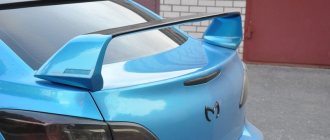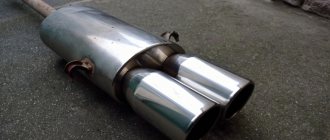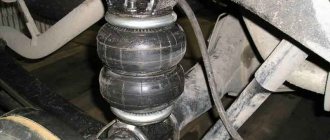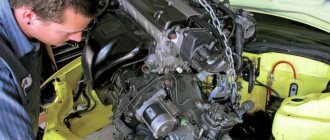What is a direct-flow exhaust system
To understand why to install a direct-flow muffler, you need to know how the car exhaust system works as a whole and what its tasks are.
Main goals:
- Filling the cylinders with a prepared fuel-air mixture, and in diesel cars - forming the fuel mixture in the combustion chamber;
- Ensuring the removal of spent fuel gases from the engine and passenger compartment outside the vehicle;
- Reducing the emission of toxic gases and harmful substances into the atmosphere thanks to the built-in catalytic converter;
- Reducing noise levels in the cabin and surrounding area.
The operating principle of the exhaust system is partly based on the law of inertia.
Thanks to the action of this law, a vacuum zone is formed behind the exhaust valve into which gases rush, and their place is immediately taken by a fresh portion of the fuel mixture.
This happens due to the fact that the phases of fuel intake and exhaust gases overlap each other, as is provided for in the design of modern engines.
After the exhaust valves are closed, next to the high-pressure zone formed as a result of exhaust gases escaping under pressure, another low-pressure zone is formed in the manifold, which moves along the exhaust pipe at the speed of sound.
Entering the muffler, the vacuum zone encounters resistance in the form of partitions, is reflected and goes in the opposite direction to the valves.
The ideal case is when this zone approaches the motor at the moment the valves open, but this depends on the frequency of the engine and the distance to the obstacle.
And since in modern cars such a distance is large, the vacuum zone from one cylinder, as a result, at the moment the valve opens, ends up in another, and not in the one from which it left.
Thanks to the design of the “spider” (exhaust manifold), where pipes of the same length are provided, the effect of vibration damping occurs, since the vacuum zones go from 4 pipes into one, where resistance is created at the junction of the latter, and they also partially dampen each other.
But the muffler plays a leading role in noise reduction, because the exhaust manifold and other elements are unable to greatly reduce noise.
But on many sports cars such a device may not be found; the role of a muffler there is played by a special turbine, which smoothes out vibrations and reduces the force of the exhaust by grinding the outgoing gas flow.
How to make a muffler bassy
How to reduce the sound of a direct-flow muffler?
It has become fashionable to install direct-flow mufflers instead of standard ones, and it is difficult to argue against such a modernization of the car’s exhaust system, as well as the advantages that it brings. Many car enthusiasts install sports mufflers because of the special bass, noble, sporty sound that is characteristic of a direct-flow system. However, over time, bass notes can become boring, or create some problems with others, or attract additional attention from traffic police. In other words, you have a problem, how to muffle the sound of a direct-flow muffler?
Types of devices
The standard exhaust system of a modern car includes a resonator (the first one comes from the engine) and the muffler itself.
The resonator cuts off low-frequency vibrations, and the muffler cuts both low-frequency and high-frequency vibrations, which together leads to a good result.
But the above scheme, both jointly and separately, may include the following types of mufflers:
- Made of aluminized steel;
- Stainless steel;
- Silencers, limiters, absorbers and reflectors;
- Resonator type;
- Direct-flow (sports) analogues.
Aluminized steel
Devices made of aluminized steel are characterized not only by a long service life, from 5 to 10 years, but also by a high price.
It will be difficult to choose such a muffler for your car, since only a few companies produce such devices, and making it yourself will be problematic.
Stainless steel
The devices are in the inexpensive segment, but their service life is only from 2 to 5 years. A big plus is that you can match the element to almost any car.
Limiters
They are usually used as an additional device installed in front of the main one.
The operating principle is based on creating low acoustic resistance.
Structurally, this is done like this: in the pipe, a large diameter turns into a small one, then there is a sharp increase in volume according to the principle of a large bottle with a narrow neck. The sound, entering a large space, decreases.
Reflectors
Used as a secondary muffler installed after the main one.
Exhaust gases entering the device encounter a group of acoustic mirrors on their way. Reflecting from them, the gases dissipate their energy one by one, and the output is a weak sound.
Absorbers
Can be used as a main muffler. The principle of operation is based on the absorption of vibrations by a porous material, usually glass wool, the fibers of which are heated by oscillating, thereby converting sound into thermal energy. Structurally close to direct-flow analogues.
They are considered ineffective because they absorb only high-frequency vibrations and transmit low-frequency ones.
Resonator type
As a rule, they are used first in exhaust systems as additional ones.
The principle of noise absorption is based on the presence of chambers of different sizes, through which the sound is effectively muffled.
Everything is arranged like this: a pipe with slots runs through the center of the resonator, which is surrounded by chambers of different volumes. Through the slots, exhaust gases penetrate into the chambers, where their energy is lost.
After this, the sounds enter the main device, where they are further reduced.
Direct flow
They are also called sports mufflers. As a rule, they are made of stainless steel. Installed on sports and tuned cars.
After installing a direct-flow muffler, the suction of the air-fuel mixture into the cylinders is improved, and the resistance in the exhaust system created by conventional analogues is reduced.
A direct-flow muffler is structurally somewhat similar to a resonator; there is the same pipe with holes and empty cavities separated by partitions. Only the cavities themselves are filled with basalt wool (or other material), which can withstand high temperatures.
Consisting of long mineral fibers, basalt wool absorbs sounds well, but only until it is blown out of the direct flow and even special protective metal mesh does not save the situation.
If the direct-flow muffler, when you tap on it, begins to sound like an empty metal container, then it needs to be filled again with cotton wool or replaced. And the sound produced by the exhaust system will be different.
Car muffler filler
The question of filler for a car muffler makes sense when discussing direct-flow devices, which automakers do not install as standard. But many people become clients of tuning workshops, wanting to change the usual sound of their car to an expressive roar or add another 5-10% to engine power. Such an additive is possible if all obstacles that the exhaust gases have to overcome before escaping into the atmosphere are removed:
Their operating principle is based on the fact that many holes are drilled in a straight pipe, through which the acoustic wave propagates outward and enters a layer of porous absorber. Due to the friction of particles and vibration of fibers, the energy of the sound wave is effectively converted into heat, which solves the problem of reducing exhaust noise.
Mineral wool for muffler
The material used as packing is exposed to extreme influences of hot gases, the temperature of which can reach +800°C, and operates under pulsating pressure. Low quality fillers do not withstand such use and “burn out” quickly. The sound-absorbing properties of the part disappear completely and an unpleasant loud ringing hum appears. You need to replace the packing in a workshop or yourself.
Basalt wool
Stone or basalt wool is made from molten rocks of the basalt group. It is used in construction as insulation due to its durability and non-flammability. Capable of withstanding temperatures up to 600-700°C for a long time. Thanks to a wide range of densities, it is possible to select a material with the required load resistance.
Basalt wool is easy to buy in construction supermarkets. Unlike asbestos, it is not hazardous to health. It differs from other mineral boards in its structure, in which the fibers are located in two planes - both horizontally and vertically. This increases the service life of the material used as a car muffler pad.
Glass wool
Another type of mineral fiber material made from the same raw materials as in the conventional glass industry. It is also widely used in construction as a heat-insulating and sound-proofing material, therefore it is inexpensive and available for purchase. However, the temperature limit of its operation is much lower than that of basalt, and does not exceed 450°C. Another unpleasant property: the substance, when subjected to mechanical action (finding itself in a stream of hot gas), quickly disintegrates into microscopic crystals.
Asbestos
Sometimes a person who has undertaken to repair the exhaust of his car on his own is tempted to fill the car muffler with asbestos. The truly outstanding thermal insulation qualities of this material, which can withstand heating up to 1200-1400°C, are attractive. However, the severe harm to health that asbestos causes when its particles are inhaled has been irrefutably established.
Exhaust gasket kit
For this reason, the economic use of asbestos is limited only to those areas where it is irreplaceable, subject to compliance with protective measures. The need to risk oneself for the sake of the conditional pleasure of the “signature sound of a car exhaust” raises serious doubts.
Handmade remedies from folk craftsmen
In search of the best solution when replacing the muffler packing, folk art finds original options. There are reports on the use of metal scourers for washing dishes and various heat-resistant fibers for this purpose. The most reasonable experience seems to be the use of steel shavings from metalworking waste.
Sounds made and their features
After installing a direct-flow exhaust system, the sound emanating from the car immediately changes; as a rule, it is low-frequency “growling”, “bass” and “mumbling”.
This happens because mineral wool placed in the co-current cavities removes only the high frequencies, while leaving the low bass unchanged.
The resistance to exhaust gases is also greatly reduced, and this affects the increase in engine power (but only in combination with other measures).
But the nature of the sounds largely depends on the number of holes and their diameter in the central pipe, as well as the characteristics of the material embedded in the cavity.
As was noted, mineral wool does not support low frequencies, and in most cases the engine produces sounds in the low range.
Therefore, it is not surprising when a car with direct flow makes sounds of engine operation through the muffler, and the higher the frequency the latter operates, the more it clogs the ears.
This is felt especially well inside the car, when such sounds, coinciding in frequency with body vibrations (and they are close to the frequency of the engine), lead to resonant vibrations inside the car and the strength of the sound increases significantly.
Therefore, it is almost impossible to make a quiet direct-flow muffler.
Types of mufflers and their differences
There are 4 types of mufflers based on the method of absorbing acoustic waves:
The reflective circuit is reverse-flow, the rest are direct-flow.
Reflective
If one muffler is installed in a car, then a reflective version is used. It uses the principle of “breaking” the flow of exhaust gases by creating several partitions, expansion chambers and turns. Exhaust volume is reduced to standard levels. For this reason, the vast majority of factory vehicles are equipped with the reflective type.
most popular for factory vehicle configuration
The disadvantage of this type of muffler is the reduction in engine power due to the resistance of the exhaust system to the flow of exhaust gases.
Resonator
A resonator muffler is installed as the first stage in the exhaust system of powerful engines. It consists of a perforated pipe placed in a housing. The body is divided into two or three sections. The energy of the exhaust gases is weakened due to a stepwise reduction in pressure.
installed as the first stage of exhaust energy suppression
The part reduces the force of sound vibrations and maintains engine power with a free flow of exhaust gases.
Restrictive
In restrictive mufflers, the gas flow passes through a diaphragm or cone narrowing, which leads to a decrease in engine power. The acoustic protection of such devices is low, since the diaphragm does not interfere with the rectilinear movement of the sound wave.
Absorption
The damping function for sound vibrations in the absorption muffler is performed by a finely porous non-flammable material located in the space between the perforated pipe and the housing. The design is similar to the resonator type. This type has little effect on power reduction.
Power and forward flow, three different opinions
Many owners of VAZ cars or, for example, Mitsubishi Lancer 10, Mazda 3, installing direct-flow exhaust systems on their vehicles pursue several goals, as a rule, there are two of them:
- Tuning your car;
- Increase the engine power, they say installing a sports analogue will leave many behind when starting at a traffic light.
The first opinion is that this is true. There is no debate about tuning; we are missing this point. But there is another opinion about increasing power, and it is the opposite.
The second opinion is that a sports muffler without deep tuning of the engine will not give an increase in power and partly it coincides with the opinion of experts.
The third opinion from professionals is that a noticeable increase in engine power is possible only after significant processing, and a direct-flow muffler is a secondary part of the issue.
The tuned power unit produces more exhaust gases, and, therefore, the standard exhaust system will not cope with its tasks, especially at high speeds.
Therefore, it will be necessary to increase the diameter of all pipes, install a tuned manifold, and only then a direct-flow muffler.
It is on sports cars that they install not simple engines, but ones that require special attention. And the direct-flow exhaust system fits into the overall picture of the tuning engine.
Direct flow and its essence
The design of a direct-flow muffler is quite simple. The whole point lies in that same pipe with a large diameter. Its curves are smoothed out, and the number of joints is minimal. You won’t find a noise absorber here; its properties are taken over by the special geometry of the device. It significantly facilitates the path of exhaust gases, allowing them to quickly and easily leave the internal combustion engine system. All this has a significant impact on the blowing, which results in an increase in efficiency by as much as 15%.
In words, everything looks simple: I replaced the standard muffler with a large pipe and that’s it. In reality, everything is much more complicated.
Installing direct flow independently requires considerable experience and certain skills.
In addition, during the tuning process, other components of the exhaust system are also modified, not just the muffler.
Making a direct-flow muffler with your own hands
If you want to manufacture and install direct flow on your car, then it is better to conduct such experiments with domestic cars, for example, VAZ.
It is better to tune the exhaust system of Mitsubishi Lancer 10, Mazda 3 and other foreign cars by contacting special companies that do this professionally.
We discussed the design of the direct flow above. The difference between a sports muffler and a regular muffler is shown below.
We will be tuning the exhaust system of a VAZ-2110 (8 valve 1.6 liter volume).
To do this you will need the following materials and tools:
- Metal pipe with a diameter of 52 millimeters (a little more than 2 inches);
- Grinder with a disc for cutting metal 1 (1.6) mm;
- Welding machine, preferably inverter;
- Metal sponges (brushes) for cleaning dishes - at least 50 pcs.
Work progress
Dismantle the old device or prepare a similar one taken, for example, from disassembly.
Cut out the gutter and all the insides as shown below.
Leave a 4 cm protrusion on both sides so that a new pipe can be welded into this area.
Prepare a new pipe by cutting it to size and drilling holes with a diameter of 6-8 mm in it at a distance of 1-2 cm from each other.
This is labor-intensive work, so you can use an alternative method - using a grinder with a 1.6 - 3.2 mm disc, cut holes in the pipe in the shape of a herringbone at a distance of 1-2 cm from each other.
Weld a pipe with holes to the sections in the muffler and fill the entire space with metal pipe cleaners.
On the reverse side, the electrode may be missing, no problem, the hole left will be additional to the rest drilled or sawn. But if you go by principle, you will have to cut out the other side of the muffler.
Weld the outer part back and, if necessary, update the pipe running from the forward flow towards the exhaust.
Completely clean the device, prime it with primer and paint, this will extend its service life.
It’s worth taking a closer look at the filler. In the example described above, a metal mesh was used, but still the best option would be expanded clay (in the middle), and put fire-resistant mineral wool on top.
What is a flute in a direct-flow muffler, and what is its effect?
To make the forward flow quieter and get “passing” decibels at the output, a simple design is used, which motorists call a flute. This is a piece of perforated tube with a length of 180–250 mm and a diameter of slightly more than 1/3 of the exhaust, with a welded plug washer in the form of a disk, cylinder or cone, which is bolted inside the forward flow, at the air cut, thereby allowing it to be muffled.
The principle of operation of the flute for direct flow is that when the cross-section of the exhaust channel changes and exhaust gases exit through the perforations, the following occurs:
The correct name for this flute is silencer (from the English silencer - muffler), and it is included in the set of expensive exhaust systems that are sold on the Internet. You can also purchase separately, the average price of good European models is 70–150 dollars, and mass ones from the Middle Kingdom - from 450 rubles.
We make direct flow from scratch
To do this you will need to use the services of a turner. We order two pipes:
- One made of steel 2 mm thick with a diameter of 130 mm and a length of 42 mm.
- The second is made of steel with a thickness of 2.5 mm, a diameter of 52 mm and a length of 42 mm with holes with a diameter of 8-10 mm, every 2 cm;
Two flanges with a diameter of 130 mm with an internal hole of 52 mm, metal thickness 2-2.5 mm can be ordered separately.
Prepared:
- Asbestos rope;
- Glass wool or mineral wool.
Asbestos rope is wrapped around the inner pipe. This is done in order to protect the mineral wool, which will be the top layer, from overheating.
We fill the top layer, assemble and scald the structure. We weld the fasteners and attach the forward flow to its regular place. For beauty, you can put a muffler attachment on it.
Another design of the device is shown below.
Blueprints
There are a lot of ways to make a direct-flow muffler; the main thing here is to understand the principle of operation of the device and use your imagination. And for car owners who find it difficult to do this, use the methods and drawings described above, they are simple and accessible to many.
Also tell us in the comments what type of forward flow is installed on your car and how you can do it yourself, this will help many people understand this topic.
Communities › Exhaust Systems and Intake › Blog › Homemade muffler. What affects the sound?
Why is that? The reason is the extremely small volume of the can itself. On the sides the flute practically touched the body. A small amount of padding which, accordingly, has an extremely insignificant effect on the sound. In short, failure. I did the second one. PPSh. Thanks to the shape, primarily the larger width, the sound here was already successful.
A pit bike with an engine capacity of 140 cubic meters sounded like 450. Everyone was happy with the result.
The next muffler that gave me a problem was a muffler for a stand-up motorcycle. The task was to fit the muffler under the belly, and make the sound bassy at the bottom and aggressive at high speeds. What I've done? Firstly, aluminum was used as the body material; this is very important for obtaining bass. Secondly, I filled all the free space under the belly with the body in order to squeeze out the maximum volume. I already said, the larger the volume, the better. Although it still wasn’t enough...
This is how I built the insides. First, a reverse cone made of perforated steel, which at the base (at the entrance to the muffler, respectively, at the edge of the exhaust pipe) is twice as large in diameter as the pipe itself. As a result, the energy of gases, due to a sharp increase in the cross section, drops sharply. Next, the flow of gases is compressed again, but in a cone made of perforated material, behind which there is packing. Which in this situation works very effectively. I made the outlet hole of the reverse cone slightly smaller than the diameter of the exhaust pipe. And behind the reverse cone, at the outlet of the muffler, there is a straight cone, like a horn. The point is that at low speeds the flute in the form of a reverse cone adds bass. And the horn at the output at maximum speed, high throttle speed, adds an aggressive note. The video shows a comparison with Yoshimura, who, by the way, is very good. The goal was not to make it quiet; the motorcycle is not for the street.











